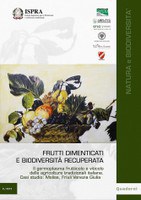Forgotten Fruits and recovered biodiversity - The wine and fruit germoplasm of traditional Italian agriculture. Case study: Molise, Friuli Venezia Giulia
This is the fourth publication by the Institute for. Environmental Protection and Research (ISPRA) designed to survey and encode forgotten fruits and recovered agrodiversity, in its efforts to promote the conservation and characterization of plant and animal biodiversity.
For the organoleptic and nutraceuticals characteristics, resistance to pathogens and adaptation to local climate, the diffusion of this variety allows to restrict the use of pesticides and fertilizers and water consumption helping to promote the greening of agricultural activities, with particular reference to protected areas, that could be identified as experimental living laboratories also on the basis of the information collected in this series.
The dissemination of knowledge about the local cultivars of locally selected edible species (often resistant to diseases, aridity and able to grow disadvantaged on soils), is essential, for sustainable development of farming and quality of the products identified by European Regulations, Directives and Agricoltural Politics, by the National Consolidated Environment and by Italian strategies for “Biodiversity” and “for Research and Innovation in agriculture food and forestry”.
Publication available only on-line

